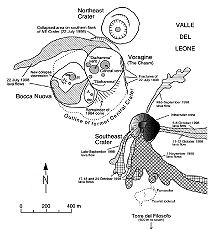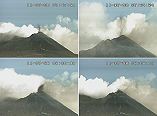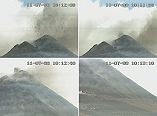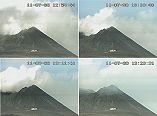Etna Activity November 1998 [ Etna Home Page | Italian volcanoes map | Main Index | Home Page ]
Etna Decade Volcano, Sicily, Italy
Updates November 1998
The most recent updates
Etna news archive
30 November 1998
The 13th eruptive episode of SE Crater occurred during the forenoon of 29 November, again after a quiet interval of 11 days, like before the previous episode on 18 November. Due to bad weather conditions, the activity could not be observed, but loud detonations were audible over a wide sector around the volcano, as far as Taormina (some 25-30 km from the summit). It is likely that this eruptive episode was of a similar character as its predecessors. More detail will be provided as weather conditions improve (see more recent Etna news).
18 November 1998
After 11 days of silence SE Crater has produced its 12th eruptive episode in nine weeks. The culminating phase occurred today at around 1030-1130 h (local time = GMT+1h) with high lava fountains, frequent emissions of ash and copious lava overflow onto the southern flank of the cone, similar to previous episodes although this time there appears to have been much more ash production.
After several days of weak seismicity, earthquakes began to increase in frequency yesterday during the late afternoon (information from G. Patanè of the Osservatorio Sismologico di Acireale and IGGUC), and weak Strombolian activity began sometime around 2000 h (information from J.C. Tanguy). This activity continued throughout the night, gradually increasing in vigor. Tanguy observed the summit area with binoculars from Trecastagni this morning at around 0830 h, and there was still no lava outflow. Intense lava fountaning and ash emission accompanied by the overflow of lava through the breach in the southern crater rim between approximately 1030 and 1140. By 1230, most pyroclastic activity had ceased, and lava movement apparently stopped although vigorous steaming from the new lava continued for some time and intense seismicity persisted for some time.
There has been further growth of the summit of SE Crater (which is the former intracrater cone that now fills the former SE Crater depression almost completely), mainly on the western crater rim, while the eastern crater rim appears to have grown little in spite of the strong wind which blew the ejecta to the east.
The interval between episodes #11 and #12 has been precisely 11 days, longer than any interval since the current eruptive sequence began on 15 September.
16 November 1998
The 12th eruptive episode of SE Crater which has been expected to occur around Friday 13 November has not yet taken place. Bad weather had prevented visual observations during most of the time since 11 November, and any activity would have gone unseen. Brief and incomplete glimpses of the summit area on Saturday revealed the presence of dark lava flows at the base of the SE Crater cone, in spite of recent heavy snowfalls, and it appeared that they were very fresh. However, these lavas are of the 7 November eruptive episode; there has been no significant activity since that day, as revealed by the absence of intense seismic activity typical of paroxysmal eruptive activity (information from G. Patanè of the Osservatorio Sismologico di Acireale and IGGUC) and the lack of morphological changes to the summit (formerly intracrater) cone of the SE Crater. Yesterday Sandro Privitera (IGGUC) reached the Torre del Filosofo mountain hut, in spite of extreme weather conditions and witnessed a single ash emission from the vent of the active cone before clouds hampered further observations; he remarked that no noise was audible. There are reports that early this morning very weak Strombolian (?) activity may have occurred at the crater. If these observations are accurate, then SE Crater is building for the long-expected 12th eruptive episode, which should occur within the next 24 hours. Today viewing conditions are perfect and significant eruptive activity will be plainly visible unless the weather worsens again.
10 November 1998
SE Crater has remained completely quiet since its latest eruptive episode on Saturday 7 November, and there has been continued weak activity in Bocca Nuova and Voragine. A new eruptive episode from SE Crater will probably occur towards the end of this week, possibly on Friday - if the intervals between episodes are really becoming shorter. Like previously, the paroxysmal phase of the episode will be preceded by the resumption of mild Strombolian activity about one day before, and by seismic activity a few hours before the onset of the most vigorous activity.
As more information has come in regarding the 7 November eruptive episode, the time of its beginning has been corrected in the previous update (0830 instead of 1000 h), and I post some additional telecamera shots captured by some of the people acknowledged above.
7 November 1998
This morning, SE Crater erupted vigorously for the eleventh time since 15 September, six days after episode #10. Strombolian activity had resumed yesterday (as noted in the previous update), indicating that a new eruptive episode was possible within the following 24-36 hours. Indeed, it came after less than 20 hours. Strombolian activity gradually increased through the night and early morning, and the culminating phase of the episode is thought to have begun at around 0830 h (local time=GMT+1), possibly even earlier. By 1100 h, vigorous fountaining from the summit crater of the intracrater cone (mainly a vent in its northeastern part) was accompanied by copious lava outflow onto the southern flank of the cone. The lava apparently used the same spillover channel as in the previous episode, which cuts deeply into the southern crater rim. At the lower end of the ca. 30 m-long channel, a lava fan developed from where numerous flow lobes spilled down the southern and southeastern flanks of SE Crater's main cone. The new flows appear to have extended mainly southeast, partially covering the flows of the previous three episodes. The Torre del Filosofo mountain hut which stands only about 1 km south of SE Crater appears to have been spared again. Worsening weather conditions prevented observation of the activity shortly before noon, but shortly after 1330 h, the main phase of the episode was over, and no active lava was visible. Minor Strombolian activity from deep within the summit vent may continue through today evening.
Morphological changes caused by today's episode are limited to some growth of the eastern crater rim of the intracrater cone and further obliteration of the former rim of SE Crater on the southern side by the accumulation of new lava. The spillover channel has completely drained and is well visible in telecamera images; future lava effusion is likely to occur here again, and thus lava will continue to be channelled onto the southern side of the SE Crater cone.
After the previous ten eruptive episodes which showed a trend of gradually increasing intervals between each successive episode, this trend appears to have inverted, and the repose intervals may be becoming shorter. While the interval between the culminating phases of episodes #9 and #10 lasted 7 days and 10 hours, this latest interval was 6 days and 6 hours. While the significance of this shortening is not clear (it may be pure coincidence), the next eruptive episode may already be expected to occur before next Friday (13 November), but there is no reason to suspect it surely will; the only certain indicator of impending activity is, on a very short term, seismic activity related to the rapid rise of vigorosly degassing magma.
A further particular of today's eruptive episode is that it was the first since late-September (episode #5) to occur during daylight, thus contradicting any hypothesis that these episodes occur preferably during the night. The eruptive sequence initiated on 15 September is continuing, but its outcome is fully uncertain. It may be caused by the rise of a fresh batch of fluid, gas-rich magma, similar to the one assumed to have caused the September 1989 to February 1990 activity, but this time the activity is, at least until now, much weaker and less frequent, and there are no indicators that Etna is about to depart from the relative stability which have characterized its eruptive activity during the past three years and four months.
6 November 1998
Weak and infrequent Strombolian activity is occurring this evening from the SE Crater, five days after its most recent eruptive episode. This activity may have resumed only today since none was visible yesterday at about the same time. During the past month, all eruptive episodes have been preceded by similar mild Strombolian activity that began about one day before, and therefore it is assumed that the crater is preparing for its eleventh eruptive episode since the resumption of eruptive activity on 15 September. This episode, were it to occur within the next 24-36 hours, would come after a shorter interval than the previous one; until now the quiet intervals have shown a linear lengthening trend. Based on the eruptive behavior during the past few weeks, a new eruptive episode should occur not before Sunday (8 November) afternoon. A far more certain indicator of an impending eruptive episode will be seismic activity; there has indeed been some seismic activity on Etna's southern and southeastern flanks during the past few days, but this was no volcanic tremor typically prededing and accompanying the eruptive episodes. Stay tuned anyway, there will almost certainly be another spectacular display at SE Crater this weekend.
2 November 1998
Etna summit map, 1 November 1998

Sketch map of Etna's summit craters showing recent eruption products ad of 1 November 1998. The approximate extent of recent lava flows from SE Crater has been added. This map is not completely accurate regarding the distribution of the new flows but renders an impression about the "where and what" at Etna's summit craters aimed to increase the understanding of the area and knowledge of where some of the frequently-mentioned features are located.

|
The tenth eruptive episode from SE Crater in seven weeks took place on the early morning of 1 November, a few hours more than one week after the previous episode. In a characteristic repetitive pattern established during the recent eruptive episodes, the 1 November event was preceded on 31 October by the resumption of very mild Strombolian activity (too weak to be evident in the telecamera images), and an increase of seismic activity on the late afternoon of that day.
While no effusive and explosive activity was evident until shortly after midnight (observation by Giovanni Sturiale, IGGUC), lava began to spill down the southern flank of the SE Crater cone before 0030 h (local time=GMT+1), but there was almost no explosive activity. Low fountains began to play in the summit vent by 0130, and the activity continued in this relatively mild manner through at least 0430. The culminating phase began at around 0500 h and lasted about two or three hours; during this phase lava fountains continuously jetted hundreds of meters above the erupting vent, and numerous lava lobes spilled down the southern flank of the SE Crater cone. Two lobes stopped about 100-150 m short of the tourist outlook at a fumarolic area some 500 m north of the Torre del Filosofo mountain hut, other flow lobes turned southeast at the base of the cone and reached a total length of about 600 m from the crater. Loud explosion noises were audible in towns on the lower flanks of Etna, but there were no ash falls since the activity produced no tephra column.
The source of the lava was a notch in the southern rim of the summit vent of the intracrater cone through which lava overflowed from the erupting vent. It appears that initially the magma rose within the conduit and overflowed quietly without being accompanied by vigorous degassing, and this relatively quiet phase lasted a few hours. Equally, the 24 October episode was reported to have initiated with the quiet overflow of lava before vigorous fountaining marked the culminating phase of the activity.
Boris Behncke and Carmelo Monaco of the IGGUC, together with others, visited the summit craters starting on 1300 h, roughly six hours after the end of the most vigorous activity and cessation of all lava outflow. Mild Strombolian activity from SE Crater continued through the late afternoon (1700h), but there was no active or incandescent lava and one of us was able to approach close to the "spillover" point on the southern side of the intracrater cone, walking on still-hot but stagnant lava emplaced that morning. The "spillover" on the southern rim of the intracrater cone was a narrow channel about 10 m deep, whose upper sides were plastered with large spatter (indicating some spattering in the upper part of the lava flow); this channel extended to the base of the intracrater cone where it divided into two major channels that fed the lava flows on the outer southern flank of the SE Crater cone. About 20-25 m further west a similar spillover channel partly filled with 1 November ejecta was probably active during the 24 October episode.
The most striking effect of the five eruptive episodes that have occurred since one of us (Behncke) last visited the summit craters, on 5 October, is the growth of the intracrater cone which has become a imposing structure occupying almost all of the former SE Crater depression. Only a small section of the former crater rim forms a low rampart on the western side, standing 1-2 m above the base of the intracrater cone, and a terrace inclined outwards is still visible on the southern side of the intracrater cone. On all other sides the flanks of the intracrater cone have merged fully with the external flanks of the SE Crater cone. A summit crater about 25-30 m wide and elongate in NE-SW direction yawns at the summit of the intracrater cone, it is surrounded by a very irregular rim which is lowest on the southern side, and possibly there is a notch on the northeastern side. The southeastern and northern crater rims constitute the hightest point of the cone which exceeds 3230 m, compared to the former elevation of 3186 m of the highest point of the crater rim. The SE Crater has thus grown vertically about 40-50 m during the past 16 months.
The northern flank of the intracrater cone is unusally steep (>40 degrees), testifying to the agglutinated nature of the pyroclasts forming the cone which was exclusively built by the nine eruptive episodes of lava fountaining following the explosive destruction of its predecessor on 15 September.
We also observed activity at Bocca Nuova and the Voragine. In the former, the northwestern cone did not produce visible eruptions although dull explosion sounds could occasionally be heard. In the southeastern eruptive area three vents were the site of Strombolian activity. The easternmost of these, located at the base of the eastern crater wall, produced very weak and infrequent incandescent ejections and frequent explosive gas emissions. In the southernmost part of the collapse depression formed in that eruptive area, two vents erupted continuously, accompanied by very loud degassing noises audible hundreds of meters away. Occasional stronger bursts from the larger of the two vents ejected bombs as high as the crater rim (about 80 m above the vents), but none fell outside the crater, and no fresh bombs were found on the crater rim above the vents.
For the first time since the large 22 July eruption we entered the Voragine which is much shallower than before that event. The eastern crater floor is very smooth and can be accessed from the northeastern and northwestern sides. Only the large southwestern vent was erupting, but that activity was very deep-seated, and only on one occasion did bombs rise above the lip of the vent. Very little degassing occurred from the large central vent, and the general impression was that the Voragine is now quieter than at any time during the past six months.
We did not visit the NE Crater but during the stay in the summit area only a weak gas plume was seen rising from its central pit.
We are still wondering aobut the causes of the change in the activity of SE Crater and its extremely regular episodic behavior. From November 1996 until late July 1998, its activity was characterized by persistent mild Strombolian activity and continuous slow lava effusion. Although this activity experienced some fluctuations it was virtually continuous and its output was less than one cubic meter per second. This first phase of activity ended a few days after the 22 July eruption of the Voragine, and SE Crater remained quiet for about six weeks. Since its violent reawakening on 15 September, ten episodes of vigorous lava fountaining and rapid lava outflow have occurred, and only on one occasion (19 September) the crater appeared to be returning to its previous eruptive behavior. Instead, it was not. Each eruptive episode lasts several hours and is followed by days of complete inactivity. Effusion rates during the culminating phases of the episodes is in the range of several cubic meters per second. Even though being limited to the eruptive episodes which occur about once per week, the mean output of SE Crater during the past seven weeks is about one order of magnitude higher than that before July 1998.
In recent weeks Catania newspapers have repeatedly referred to the September 1989 eruptive sequence at SE Crater which consisted of numerous eruptive episodes and was followed by a dramatic flank fracturing event and eruption. However, a few remarks should be made here to distinguish the present activity from that in 1989.
- The September 1989 eruptive episodes at SE Crater were far more vigorous with lava fountains at times higher than 500 m, and the output was significantly higher than in the recent eruptive episodes.
- Eruptive episodes in September 1989 occurred once or twice daily, thus the tempo of the events was dramatically higher than it is now.
- The later episodes in the 1989 eruptive sequence were accompanied by fracturing of the northeastern and southeastern flanks of the SE Crater cone, testifying to an increasing instability of the fracture systems to which the crater is clearly linked. There has been no fracturing of the outer flanks of SE Crater during the current activity. Furthermore, there is no geophysical evidence of major magma movements (intrusions) at shallow depth which might eventually lead to a flank eruption. However, given the crucial location of SE Crater at the intersection of the two recently most active fracture systems on Etna, the slight intensification of its activity must be closely monitored in order to recognize eruptive patterns that might in the more distant future result in a flank eruption.
Page set up on 14 December 1998
Hosted by VolcanoDiscovery




